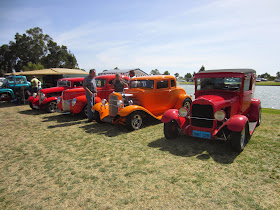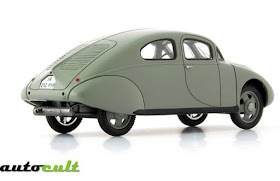
Hanomag was founded in Hannover, Germany, in 1835. The company specialized in steam engines, but soon expanded into trains, rolling stock, steam road wagons and farm equipment. In 1925 Hanomag ventured into the automotive market with a small, budget car officially called the 2/10PS, but better known as the ‘kommisbrot’ (army loaf). Largely constructed of plywood, with leatherette for weather proofing, and powered by a rear mounted, single cylinder 500cc engine, the kommisbrot was typical of the cyclecars of the period. Nevertheless, it was a popular seller, with almost 16,000 being sold.

The success of the kommisbrot led Hanomag to expand into serious car production. In 1928 they introduced a more conventional car, the 3/16PS. This was replaced in 1931 by a new small car imaginatively called the 1.1 litre. However, it was the introduction in 1934 of the 1.5 litre Hanomag Rekord that really established the company as a force on the German auto scene.

Hanomag Diesel
The diesel engine was first developed in Scotland in the late 19th century as an attempt to improve on the thermal efficiency of industrial steam engines. Rudolf Diesel, after whom the engine is now named, was fortunate enough to patent a practical working engine in 1897. The difference between diesel and petrol engine was in their ignition system. A diesel engine has no spark plug or ignition system per se but relies on highly compressing the air within the combustion chamber until the air itself reaches 550 degrees Celsius. At this point – top dead centre in the cycle – a small amount of gaseous fuel is injected into the cylinder which instantly ignites on contact with the super-heated air. As both the fuel and the air are introduced to each other in a highly volatile state, the diesel engine needs far less fuel than a petrol engine. However, the engine's main drawback was that the engine case and pistons need to be far heavier to deal with the higher compression pressures. Consequently they were seen as being more suitable to heavy industrial use, such as in ships engines, driving turbines and in trains.

Rudolf Diesel's engine was no small affair. They were soon being employed in heavy industrial use.
Despite these drawbacks, after the Great Depression, several auto manufacturers saw an opportunity to use fuel efficient diesel engines in a motorcar. Citroen was the first company to introduce a diesel engined production car when they introduced the Citroen 11UD "Rosalie" in 1934. In 1936, both Mercedes-Benz and Hanomag presented diesel engine cars at the Berlin Auto Show.

Hanomag had its start with diesel engines in 1934 with diesel engine tractors. The new car originally featured a four cylinder 1.5 litre diesel, but this was soon increased to 1.9 litres. The diesel engine however only put out a meagre 35PS. Sold as an alternative engine option for the successful Hanomag Rekord model, sales were relatively modest. Out of the 19,000 Hanomag Rekords sold only 1,100 were powered by the diesel engine.
The Rekordwagen
Wanting to promote the efficiency of its diesel engine, Hanomag’s management turned to motor sport. Although several one-off diesel cars had been raced in time trials in the United States and Great Britain in the 1920’s, Hanomag had the field to themselves for production cars with engines under 2 litres.

The Rekordwagen was fashioned from a standard Hanomag Diesel Rekord chassis and 1.9 litre D engine. The standard D engine was designed for fuel economy, not performance. In fact, the challenges of adjusting the early fuel injector technology to get more power, was perceived as one of the underlying weaknesses of the diesel engine. The engineering team managed to tune the engine to give it a little more oomph, but at 40HP the engine couldn’t really be described as high performance. Hanomag compensated for the lower horsepower by fitting the car with a streamlined aluminum body that was mounted on a lightweight tube frame.

On 8 February 1939, the Hanomag Diesel Rekordwagen was ready to make its debut on the autobahn between Dessau and Leipzig.

Days before, Hanomag’s rival, a Mercedes-Benz W154 had set a land speed record for a petrol engine car from a standing start with a speed in excess of 400 kph. The Hanomag Diesel wasn't quite in the same class.

The Rekordwagen set four world records. The first record was 89.5kph over a mile from a standing start. Once it had reached speed, it achieved a maximum speed of 156kph over both a 5 kilometre and a 5 mile course. In comparison with the Mercedes-Benz’ record, the Rekordwagen’s performance was rather modest, but Hanomag were under no illusions that they were in the same league as Germany’s premier automobile manufacturer. The Rekordwagen had done what its makers had set out to achieve – demonstrate to the world that diesel engines were capable of more than powering tractors and that Hanomag was at the cutting edge of diesel engine design.

The Dessau run proved to be the Rekordwagen’s one and only moment in the spotlight. It did not race again and was put in storage. Later, during the Second World War, the Allies bombed Hannover into rubble and Hanomag’s factory, which manufactured trucks and half-tracks for the German army, was destroyed. The Rekordwagen was destroyed along with all plans, designs and records.
Resurrection
For many years the only evidence of the Rekordwagen’s existence was a handful of publicity photographs taken on the Dessau autobahn. Then, in 2006, came the unexpected discovery of a complete set of plans and specifications for the Rekordwagen. A small group of Hanomag enthusiasts began discussing the idea of building a replica of the car. In 2007 the group was provided a donor chassis and standard engine, which they restored. Using the designs, a tube body frame was constructed. By 2012 the car was fully functional, if somewhat skeletal in appearance. Details of the project can be found here: http://www.weinberg-oldtimer.de/aktuelle-projekte/hanomag-diesel-weltrekordwagen/

The donor chassis.

The tube frame built to the original design

Taking shape


The chassis and frame come together

On the 75th anniversary of the car’s record breaking run, the incomplete but running Rekordwagen attended the commemorative race program at Dessau and even took to the A9. The car is currently on display at the Junkers Museum in Dessau beneath the wings of the museum’s signature Junkers Ju52 ‘Tante Ju.’

http://heinkelscooter.blogspot.com.au/2014/10/dessau-historic-race-program.html

The final step in the project involved complete skinning the car with its distinctive aluminum body. This was estimated to cost 60,000 euros.

The project is finally completed. Hanomag historian and project director, Horst-Dieter Gorg (left) unveils the completed car


http://www.hanomag-museum.de/html/hanomag-museum-frameset.html?http://www.hanomag-museum.de/html/video_wrd-2013_englisch.html
Book published in 2015
A German language book covering the development of the Hanomag Diesel Rekordwagen, the Dessau world record, and the reconstruction of the replica was published in 2015. http://heinkelscooter.blogspot.com.au/2015/02/hanomag-diesel-rekordwagen-book.html








































